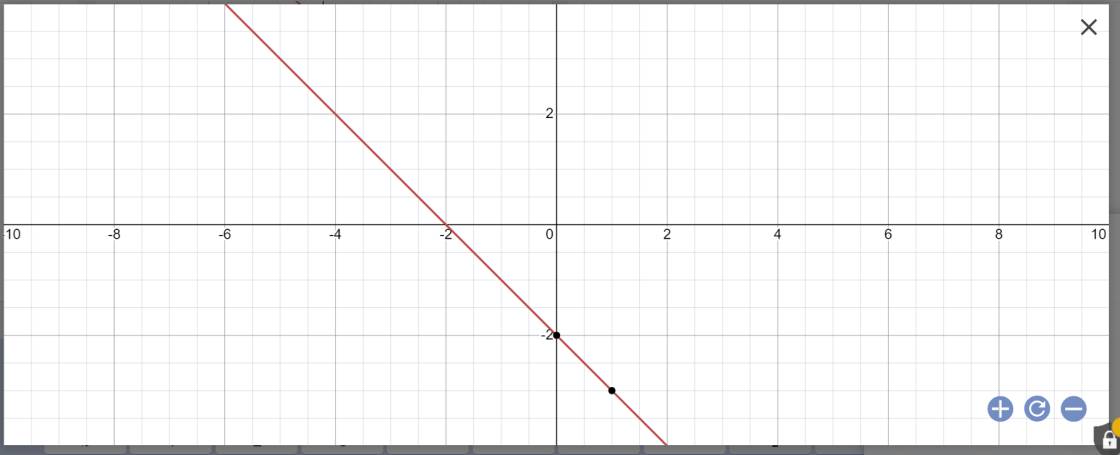Hãy nhập câu hỏi của bạn vào đây, nếu là tài khoản VIP, bạn sẽ được ưu tiên trả lời.

a: Để hàm số y=(2m+3)x-2m+5 nghịch biến trên R thì 2m+3<0
=>2m<-3
=>\(m< -\dfrac{3}{2}\)
b: Để (d)//(d1) thì
\(\left\{{}\begin{matrix}2m+3=3m-2\\-2m+5\ne1\end{matrix}\right.\)
=>\(\left\{{}\begin{matrix}-m=-5\\-2m\ne-4\end{matrix}\right.\Leftrightarrow\left\{{}\begin{matrix}m=5\\m\ne2\end{matrix}\right.\)
=>m=5
c: Thay y=5 vào y=3x-1, ta được:
3x-1=5
=>3x=6
=>x=6/3=2
Thay x=2 và y=5 vào (d), ta được:
\(2\left(2m+3\right)-2m+5=5\)
=>\(4m+6-2m+5=5\)
=>2m+11=5
=>2m=-6
=>m=-6/2=-3
d: Tọa độ A là:
\(\left\{{}\begin{matrix}y=0\\\left(2m+3\right)x-2m+5=0\end{matrix}\right.\)
=>\(\left\{{}\begin{matrix}y=0\\x\left(2m+3\right)=2m-5\end{matrix}\right.\Leftrightarrow\left\{{}\begin{matrix}y=0\\x=\dfrac{2m-5}{2m+3}\end{matrix}\right.\)
=>\(A\left(\dfrac{2m-5}{2m+3};0\right)\)
\(OA=\sqrt{\left(\dfrac{2m-5}{2m+3}-0\right)^2+\left(0-0\right)^2}=\sqrt{\left(\dfrac{2m-5}{2m+3}\right)^2}=\left|\dfrac{2m-5}{2m+3}\right|\)
Tọa độ B là:
\(\left\{{}\begin{matrix}x=0\\y=x\left(2m+3\right)-2m+5=0\left(2m+3\right)-2m+5=-2m+5\end{matrix}\right.\)
=>\(B\left(-2m+5;0\right)\)
\(OB=\sqrt{\left(-2m+5-0\right)^2+\left(0-0\right)^2}\)
\(=\sqrt{\left(-2m+5\right)^2}=\left|2m-5\right|\)
Vì Ox\(\perp\)Oy
nên OA\(\perp\)OB
=>ΔOAB vuông tại O
=>\(S_{OAB}=\dfrac{1}{2}\cdot\left|2m-5\right|\cdot\dfrac{\left|2m-5\right|}{\left|2m+3\right|}\)
\(=\dfrac{1}{2}\cdot\dfrac{\left(2m-5\right)^2}{\left|2m+3\right|}\)
Để \(S_{AOB}=1\) thì \(\dfrac{\dfrac{1}{2}\left(2m-5\right)^2}{\left|2m+3\right|}=1\)
=>\(\dfrac{\left(2m-5\right)^2}{\left|2m+3\right|}=2\)
=>\(\left(2m-5\right)^2=2\left|2m+3\right|\)
=>\(\left(2m-5\right)^2=2\left(2m+3\right)\)
=>\(4m^2-20m+25-4m-6=0\)
=>\(4m^2-24m+19=0\)
=>\(m=\dfrac{6\pm\sqrt{17}}{2}\)

a: Thay x=2 và y=-3 vào (d), ta được:
\(2\left(2m-1\right)-2m+5=-3\)
=>\(4m-2-2m+5=-3\)
=>2m+3=-3
=>2m=-6
=>\(m=-\dfrac{6}{2}=-3\)
b: Để (d)//(d') thì \(\left\{{}\begin{matrix}2m-1=2\\-2m+5\ne1\end{matrix}\right.\)
=>\(\left\{{}\begin{matrix}2m=3\\-2m\ne-4\end{matrix}\right.\Leftrightarrow\left\{{}\begin{matrix}m=\dfrac{3}{2}\\m\ne2\end{matrix}\right.\)
=>m=3/2
Thay m=3/2 vào (d), ta được:
\(y=\left(2\cdot\dfrac{3}{2}-1\right)x-2\cdot\dfrac{3}{2}+5=2x+2\)

y=2x+2 nên a=2
Gọi \(\alpha\) là góc tạo bởi (d) với trục Ox
\(tan\alpha=2\)
=>\(\alpha\simeq63^026'\)

2:
a: Khi m=-1 thì hệ phương trình sẽ là:
\(\left\{{}\begin{matrix}2x+y=-3+1=-2\\3x+2y=-2-3=-5\end{matrix}\right.\)
=>\(\left\{{}\begin{matrix}4x+2y=-4\\3x+2y=-5\end{matrix}\right.\Leftrightarrow\left\{{}\begin{matrix}x=1\\2x+y=-2\end{matrix}\right.\)
=>\(\left\{{}\begin{matrix}x=1\\y=-2-2x=-2-2=-4\end{matrix}\right.\)
b: \(\left\{{}\begin{matrix}2x+y=3m+1\\3x+2y=2m-3\end{matrix}\right.\)
=>\(\left\{{}\begin{matrix}4x+2y=6m+2\\3x+2y=2m-3\end{matrix}\right.\)
=>\(\left\{{}\begin{matrix}4x+2y-3x-2y=6m+2-2m+3\\2x+y=3m+1\end{matrix}\right.\)
=>\(\left\{{}\begin{matrix}x=4m+5\\y=3m+1-2x=3m+1-8m-10=-5m-9\end{matrix}\right.\)
x<1 và y<6
=>\(\left\{{}\begin{matrix}4m+5< 1\\-5m-9< 6\end{matrix}\right.\Leftrightarrow\left\{{}\begin{matrix}4m< -4\\-5m< 15\end{matrix}\right.\)
=>\(\left\{{}\begin{matrix}m< -1\\m>-3\end{matrix}\right.\Leftrightarrow-3< m< -1\)
Bài 1
ĐKXĐ: m ≠ 3
a) Thay x = 0; y = -2 vào hàm số, ta có:
(m - 3).0 - 2m + 2 = -2
⇔ -2m = -2 - 2
⇔ -2m = -4
⇔ m = -4/(-2)
⇔ m = 2 (nhận)
Vậy m = 2 thì đồ thị hàm số cắt trục tung tại điểm có tung độ là -2
b) Để (d) // (d1) thì:
m - 3 = 3m + 1 và -2m + 2 4
*) m - 3 = 3m + 1
⇔ 3m - m = -3 - 1
⇔ 2m = -4
⇔ m = -2 (nhận)
*) -2m + 2 ≠ 4
⇔ -2m ≠ 4 - 2
⇔ -2m ≠ 2
⇔ m ≠ -1
Vậy m = -2 thì (d) // (d1)
c) (d) cắt trục hoành nên:
(m - 3)x - 2m + 2 = 0
⇔ (m - 3)x = 2m - 2
⇔ x = (2m - 2)/(m - 3)
= (2m - 6 + 4)/(m - 3)
= 2 + 4/(m - 3)
x nguyên khi 4 (m - 3)
⇒ m - 3 ∈ Ư(4) = {-4; -2; -1; 1; 2; 4}
⇒ m ∈ {-1; 1; 2; 4; 5; 7}
Vậy m ∈ {-1; 1; 2; 4; 5; 7} thì (d) cắt trục hoành tại điểm có hoành độ là số nguyên

a) Khi m =2 thì y = 3x - 1
(Bạn tự vẽ tiếp)
b) Để \((d)//(d_{1})\) thì \(\begin{cases} 2m-1=-3\\ -3m+5\neq2 \end{cases} \) ⇔ \(\begin{cases} m=-1\\ m\neq1 \end{cases} \) ⇔ \(m=-1\)
c)
Để \((d) ⋂ (d1)\) thì \(2m-1\neq-3 \) ⇔ \(m\neq-1\)
Giao điểm của 2 đường thẳng thuộc trục tung => x=0
Khi đó, ta có: \(y=-3.0+2=2\)
⇒ Điểm \((0;2)\) cũng thuộc đường thẳng (d)
⇒ \(2=(2m-1).0-3m+5\) ⇔ \(m=1\) (TM)

b: Để (d)//y=-3x+2 thì m-1=-3
=>m=-2
c:
PTHĐGĐ là:
(m-1)x-4=x-7
=>(m-2)x=-3
Để hai đường cắt nhau tại một điểm nằm bên trái trục tung thì m-1<>1 và -3/(m-2)<0
=>m<>2 và m-2>0
=>m>2

Sửa đề: (d): y=(m-3)x-2m+2
a: Để hàm số đồng biến thì m-3>0
=>m>3
b: Khi m=2 thì (d): y=(2-3)x-2*2+2=-x-2

c: Để hai đường song song thì
\(\left\{{}\begin{matrix}3m+1=m-3\\-2m+2< >4\end{matrix}\right.\)
=>\(\left\{{}\begin{matrix}2m=-4\\-2m< >2\end{matrix}\right.\Leftrightarrow m=-2\)
d: tọa độ A là:
\(\left\{{}\begin{matrix}y=0\\\left(m-3\right)x-2m+2=0\end{matrix}\right.\Leftrightarrow\left\{{}\begin{matrix}y=0\\x=\dfrac{2m-2}{m-3}\end{matrix}\right.\)
=>\(OA=\left|\dfrac{2m-2}{m-3}\right|\)
Tọa độ B là:
\(\left\{{}\begin{matrix}x=0\\y=0\left(m-3\right)-2m+2=-2m+2\end{matrix}\right.\)
=>\(OB=\left|-2m+2\right|=\left|2m-2\right|\)
ΔOAB vuông cân tại O
=>OA=OB
=>\(\left|2m-2\right|=\left|\dfrac{2m-2}{m-3}\right|\)
=>\(\left|2m-2\right|\left(\dfrac{1}{\left|m-3\right|}-1\right)=0\)
=>\(\left[{}\begin{matrix}2m-2=0\\m-3=1\\m-3=-1\end{matrix}\right.\Leftrightarrow\left[{}\begin{matrix}m=1\\m=4\\m=2\end{matrix}\right.\)

b: Để hai đường song song thì m+1=-2
=>m=-3
c: Gọi A,B lần lượt là giao của (d) với trục Ox và Oy
=>A(-3/m+1;0), B(0;3)
=>OA=3/|m+1|; OB=3
1/2*OA*OB=9
=>9/|m+1|=18
=>|m+1|=1/2
=>m=-1/2 hoặc m=-3/2

b: Để (d)//(d1) thì m-2=-5 và 2<>1(đúng)
=>m=-3
c: Tọa độ A là:
\(\left\{{}\begin{matrix}y=0\\\left(m-2\right)x+2=0\end{matrix}\right.\Leftrightarrow\left\{{}\begin{matrix}y=0\\x=\dfrac{-2}{m-2}\end{matrix}\right.\)
=>\(OA=\dfrac{2}{\left|m-2\right|}\)
Tọa độ B là:
\(\left\{{}\begin{matrix}x=0\\y=\left(m-2\right)\cdot0+2=2\end{matrix}\right.\)
=>OB=2
\(S_{OAB}=1\)
=>\(\dfrac{1}{2}\cdot OA\cdot OB=1\)
=>\(\dfrac{1}{2}\cdot2\cdot\dfrac{2}{\left|m-1\right|}=1\)
=>\(\left|m-1\right|=2\)
=>\(\left[{}\begin{matrix}m-1=2\\m-1=-2\end{matrix}\right.\Leftrightarrow\left[{}\begin{matrix}m=3\\m=-1\end{matrix}\right.\)

a: Thay x=4 và y=1 vào y=(m+1)x-3, ta được:
4(m+1)-3=1
=>4m+4-3=1
=>4m+1=1
hay m=0
b: Để hai đường vuông góc thì 5(m+1)=-1
=>m+1=-1/5
hay m=-6/5
c: Thay x=2 vào y=3x-1, ta được:
\(y=3\cdot2-1=5\)
Thay x=2 và y=5 vào (d), ta được:
2(m+1)-3=5
=>2(m+1)=8
=>m+1=4
hay m=3